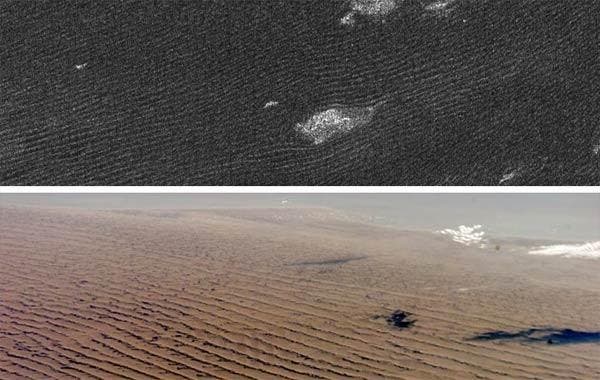New experimental research found that Saturn’s largest Moon, Titan, has much stronger winds than previously believed. These rogue winds actually shape the hydrocarbon dunes observed on its surface.

Credit: NASA
Titan is, along with Earth, one of the few places in the solar system known to have fields of wind-blown dunes on its surface. The only other ones are Mars and Venus. Now, researchers led by Devon Burr, an associate professor in Earth and Planetary Sciences Department at the University of Tennessee, Knoxvillehas haves hown that previous estimates regarding the strength of these winds are about 40% too low. In other words, Titan has much stronger winds than previously believed.
Titan is the only known moon with a significant atmosphere, and just like Earth’s atmosphere, it is rich in nitrogen. The geological surface of the moon is also very interesting, with active geological processes shaping it. The Cassini spacecraft captured spectacular images of seas on Titan, but before you get your hopes up, you should know that the seas are not made of water, but of liquid hydrocarbons. However, many astronomers believe that Titan actually harbors an ocean of liquid water, but below its frozen surface – the surface temperature is –290° F (–180° C). It’s actually so cold, that even the sand on Titan is not like the sand on Earth – the sand is also made from solid hydrocarbons. But the thing is, we don’t really know where those grains come from.
“It was surprising that Titan had particles the size of grains of sand — we still don’t understand their source — and that it had winds strong enough to move them,” said Burr. “Before seeing the images, we thought the winds were likely too light to accomplish this movement.”
But the biggest mystery was the shape of the dunes. The Cassini data showed that the predominant winds that shaped the dunes blew from east to west. However, the streamlined appearance of the dunes around obstacles like mountains and craters suggested that the winds blow from the opposite direction.
In order to figure this out, Burr and his team spent six years refurbishing a defunct NASA high-pressure wind tunnel to recreate Titan’s surface conditions. After the restauration was complete, they used 23 different varieties of sand in the wind tunnel to compensate for the fact that we don’t know exactly what the sand on Titan is made from. The first thing they found is that for all the likely varieties of sand, the winds have to be much stronger than believed.
“Our models started with previous wind speed models but we had to keep tweaking them to match the wind tunnel data,” said Burr. “We discovered that movement of sand on Titan’s surface needed a wind speed that was higher than what previous models suggested.”
They also found an explanation for the shape of the dunes.
“If the predominant winds are light and blow east to west, then they are not strong enough to move sand,” said Burr. “But a rare event may cause the winds to reverse momentarily and strengthen.”
According to the models, this wind reversal takes place every Saturn year – which is 30 Earth years. This also explains why Cassini missed this reversal.
“The high wind speed might have gone undetected by Cassini because it happens so infrequently.”
Journal Reference:
- Devon M. Burr, Nathan T. Bridges, John R. Marshall, James K. Smith, Bruce R. White, Joshua P. Emery. Higher-than-predicted saltation threshold wind speeds on Titan. Nature, 2014; DOI: 10.1038/nature14088






